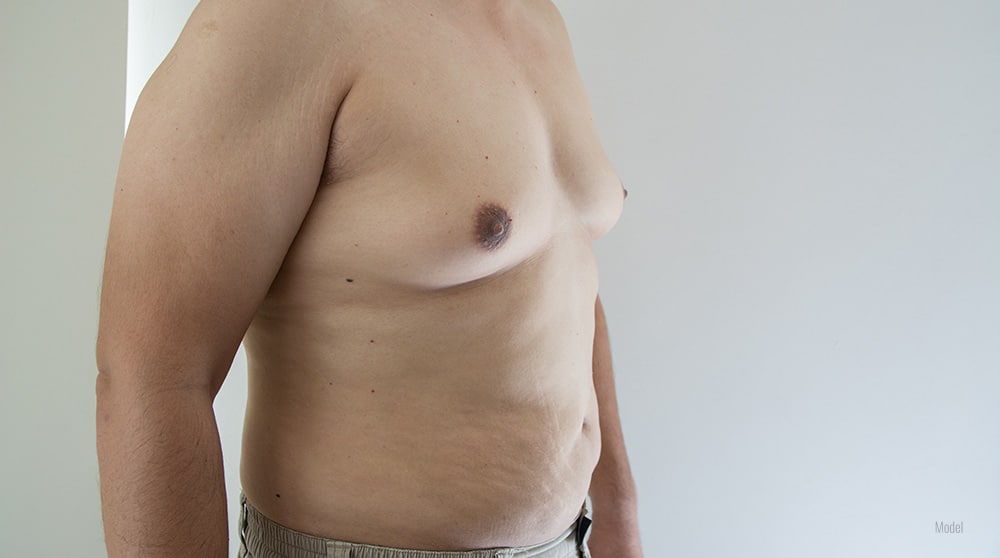True gynecomastia and pseudogynecomastia are two distinct conditions that involve excess tissue in the breasts of men and are often mistaken for one another. Both can have a significant impact on self-esteem and quality of life. In this comprehensive guide, we’ll explore the effectiveness of liposuction, highlighting that the procedure does not adequately treat gynecomastia because it does not remove the breast gland. True gynecomastia requires gland excision. However, this is often also combined with liposuction for blending. Liposuction alone is only a corrective procedure for pseudogynecomastia.
4 Min Read:
What Is Gynecomastia?
The enlargement of glandular tissue in the male breast, causing a feminine-like chest appearance, is known as gynecomastia. It is a common condition that can occur at any age, but due to hormonal conditions, it is most prevalent during puberty and in older men.
What Is Pseudogynecomastia?
Pseudogynecomastia, also known as lipomastia, is characterized by the accumulation of excess fat in the chest area, resulting in a breast-like appearance. Unlike gynecomastia, the enlargement caused by pseudogynecomastia doesn’t involve the proliferation of glandular tissue and is usually limited to excess adipose (fatty) tissue.
Differences Between Gynecomastia and Pseudogynecomastia
While gynecomastia and pseudogynecomastia share some similarities in their physical presentation, there are key differences between the two conditions:
- Tissue Composition: As noted, the primary difference between gynecomastia and pseudogynecomastia is the type of excess chest tissue present. While gynecomastia is defined by excess glandular tissue, often accompanied by fat, pseudogynecomastia is the accumulation of excess fat alone.
- Symptoms: Gynecomastia may present with breast tenderness, firmness, swelling, and pinchable glandular tissue, whereas pseudogynecomastia typically lacks these glandular characteristics and is often accompanied by generalized obesity.
- Causes: Both conditions can be related to hormonal imbalances, but medications, medical conditions, or genetics may also be responsible for the development of gynecomastia. Pseudogynecomastia is more generally associated with obesity, poor diet, and lack of exercise.
- Treatments: Gynecomastia surgery or male breast reduction is necessary when glandular tissue is the primary issue.
Liposuction Works for Pseudogynecomastia and Can Combine to Help Gynecomastia
As a minimally invasive surgical procedure that can effectively address excess fat and tissue in the chest area, liposuction is a popular choice for treating pseudogynecomastia but needs to be combined with gland incision to effectively address gynecomastia. During the liposuction process, small incisions are made in the chest area, and a thin tube called a cannula is inserted to suction out excess fat deposits.
Limitations of Liposuction for Gynecomastia
For individuals with gynecomastia, liposuction is not sufficient to achieve optimal results. Instead, a combination of liposuction and surgical glandular tissue excision is necessary to address both fat and glandular components of the condition. While male breast reduction addresses glandular tissue, liposuction can remove fat and help contour the chest in a complementary combination for a more masculine-looking chest.
Effectiveness of Liposuction for Pseudogynecomastia
Liposuction is highly effective for treating pseudogynecomastia, as it targets excess fat deposits in the chest area. By removing fatty tissue through liposuction, individuals can achieve a flatter, more sculpted chest contour and improve their overall physique. However, if there is excess skin involved, skin excision surgery may be required in addition to a liposuction procedure. Liposuction for pseudogynecomastia is often combined with lifestyle modifications such as diet and exercise to optimize results and prevent excess chest fat from accumulating in the future.
Benefits of Liposuction for Pseudogynecomastia and When Combined for Gynecomastia
- Minimally Invasive: Liposuction is a minimally invasive procedure involving small incisions and minimal scarring, resulting in faster recovery and less downtime than surgical fat removal techniques.
- Customized Treatment: Liposuction can be tailored to address each patient’s unique concerns and aesthetic goals, allowing for personalized treatment and outcomes.
- Improved Self-esteem: By achieving a flatter, more masculine chest contour, individuals undergoing liposuction for gynecomastia or pseudogynecomastia can experience a significant improvement in self-esteem and body confidence.
- Long-lasting Results: With resolution of underlying causes, proper post-operative care, and a healthy lifestyle, the results of liposuction for gynecomastia and pseudogynecomastia can provide long-lasting improvements in chest appearance and body proportion.
Gynecomastia and pseudogynecomastia can affect individuals of all ages, leading to physical discomfort and emotional distress. While their underlying causes and tissue composition differ, affected individuals will often seek out a surgeon’s assistance to solve either issue. Liposuction alone can positively affect pseudogynecomastia. True gynecomastia requires tissue and gland excision as well as a liposuction procedure.
By targeting excess fat in the chest area, liposuction can help individuals achieve a flatter, more sculpted chest contour. If you’re considering liposuction for pseudogynecomastia or in combination with tissue and gland excision for gynecomastia, consult with a board-certified plastic surgeon to discuss your options, determine the best course of treatment, and achieve the masculine chest appearance you desire.
Gynecomastia Correction in San Francisco, CA
Dr. Miguel Delgado is an accomplished board-certified plastic surgeon specializing in the treatment of gynecomastia in San Francisco and the Bay Area. If you’re ready to discuss your concerns about male breast reduction or liposuction surgery, call 415.898.4161 and schedule your consultation today.



